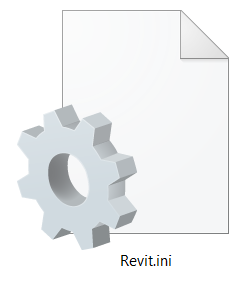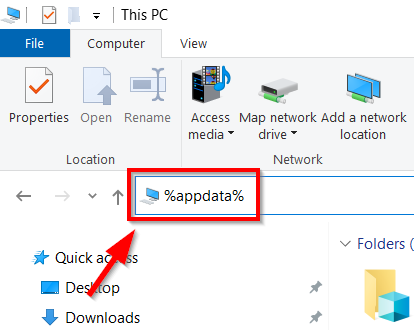In this Article...

Revit uses the Revit.ini file to store variables and settings. In the past, I usually delete my Revit.ini file to reset my Revit back to the original setting. Don’t do that! At least before trying to edit the file first. There could be many settings that will be gone if you delete the file.
The Revit.ini file contents can be different, depending on what settings you changed and what you accepted as the default value. The parameters in the file will be added as needed.
Before We Start: Backup the File First!
It is a good practice to make a backup of the Revit.ini file before you start changing it. Copy the file to another folder. You can’t rename the file and keep the original in the same folder. You must copy it to another location.
If you simply rename the file, Revit will delete it.
Where’s the File?
Open File Explorer. In the address bar, type %appdata% then press Enter.

It will open location C:\Users\username\AppData\Roaming on your computer. Navigate to Autodesk\ Revit\ Autodesk Revit 2021. Open the folder that matches your Revit version.
The location now shows C:\Users\username\AppData\Roaming\Autodesk\Revit\Autodesk Revit 2021
Copy the Revit.ini file to a save location.
Why Do I Need to Change Parameters in Revit.ini?
There are many settings that you can change in Revit.ini. However, if you only recently use Revit or haven’t changed many things in Revit options, you will not see many options here yet. Revit will add parameters as necessary.
In short: Most Revit Options
Most of the parameters are also available in Revit options. However, copying the value allows you to configure multiple options at once quickly. Imagine that you need to use a new computer or recently upgrade to a new version. You want to have the same settings available immediately. You can copy the parameters from your backup file!
However, there are parameters that you can change only in Revit.ini. The parameters that I often change in Revit.ini are:
Disabled Confirmation Dialog
When working in Revit, sometimes we see a confirmation dialog like below.

If you check the Do not show me this message again, there is no option in Revit to bring the disabled confirmation dialog back. The only way to do it is by editing the Revit.ini file. You can bring it back by changing all parameters under [Messages] and [DNSM] category to 0.
There are different values that you can use to change the behavior. You can find the Autodesk Knowledge Base details here: Do Not Show Me (DNSM) and Messages.
Disable Auto-Apply Behavior in Revit Properties Palette
In Revit 2013 or older, you need to click apply when changing a value in the Properties Palette. After that, when you move your mouse pointer away from the Properties Palette, the value will be applied automatically.
You can only change this behavior in the Revit.ini file. The parameter to change auto-apply behavior in Properties Palette is DisableMppAutoApply.
[UserInterface]
DisableMppAutoApply=1Recent File List
In the Revit home, Revit shows 5 recent files that you opened. It’s a good thing, so I don’t need to find the project I’m working on. However, sometimes I don’t want to show the files list. For example, when I do a presentation for a client or giving training.
I can remove the file list, and I also can paste the list back from my backup. The file list is under the category [Recent File List].
What Other Options Do I Have in Revit.ini?
There are tons of Revit options you can control! You can refer to the documentation here: The Revit.ini file. Remember that many of the parameters not available by default in the Revit.ini file. Revit will add them when necessary, or you can add them manually.
To Sum Up
Revit.ini is a powerful tool for customization. When you are comfortable with your settings now or set up a default setting in the company, you can utilize Revit.ini.
You can save a backup to use in a new installation or for troubleshooting. You can copy the parameters from your backup and paste them.



